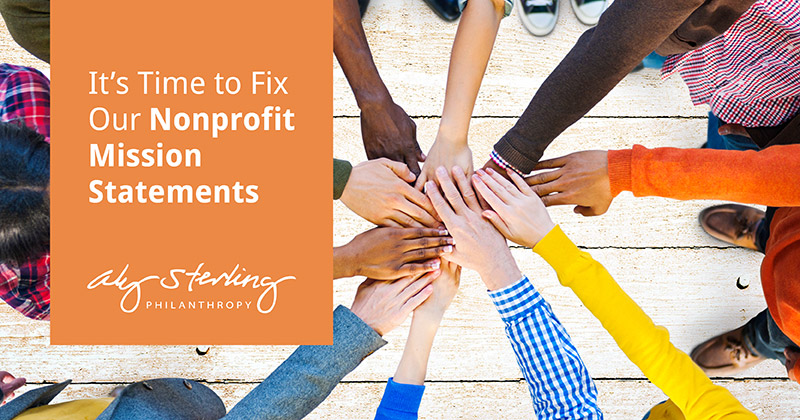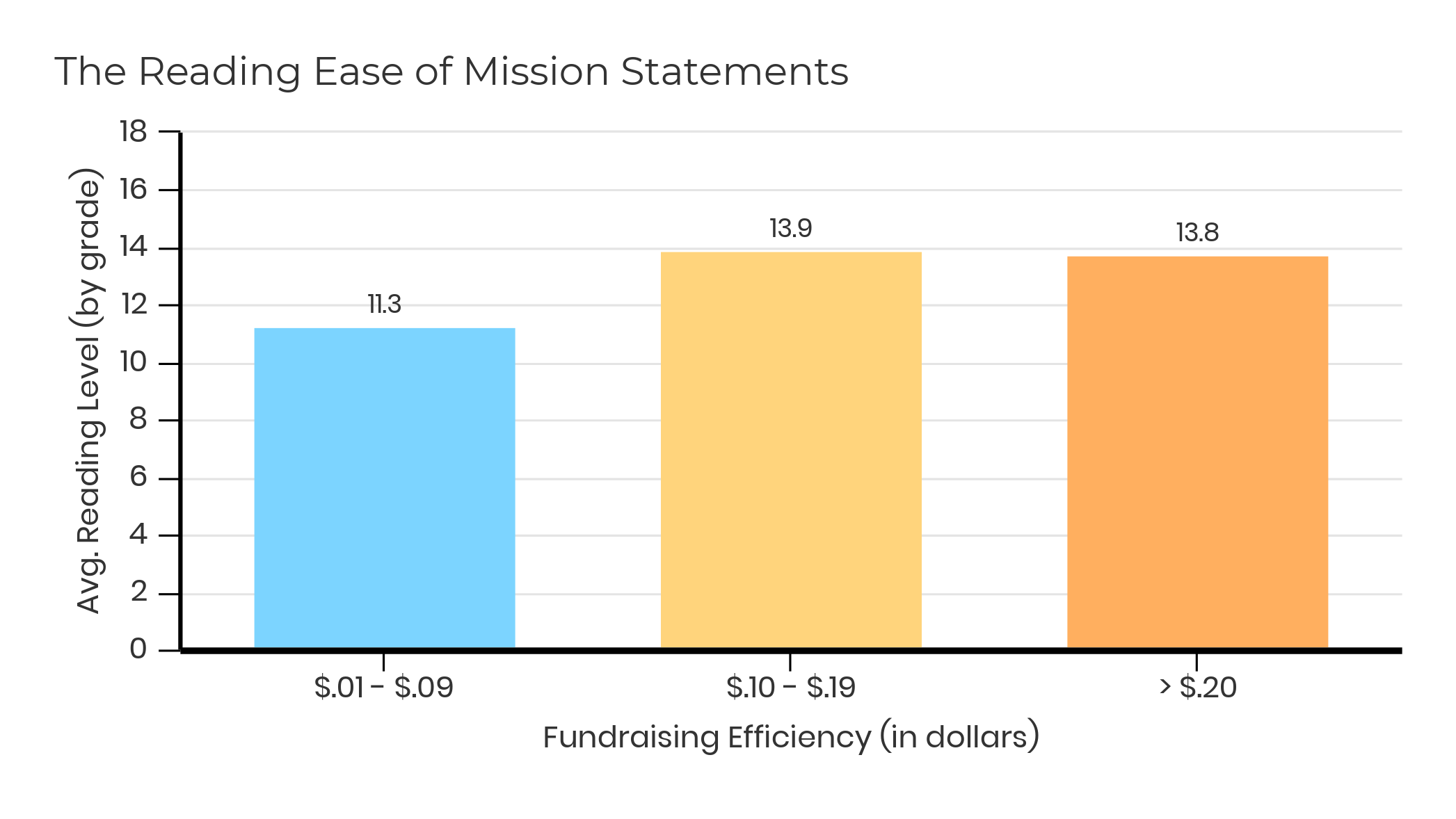
“Simple can be harder than complex: you have to work hard to get your thinking clean to make it simple. But it’s worth it in the end because once you get there, you can move mountains.”
— Steve Jobs
“If you can’t explain it to a six-year-old, then you don’t understand it yourself.”
— Maybe Albert Einstein… or Richard Feynman
When did writing with complexity become a contest? Why do we often equate convolution with intelligence and ability? Unfortunately, this is the way most of our teachers and professors taught us to write. We pedantically harp on a subject until we fill the minimum page or word counts. Then we pray that we pass Philosophy 201 with a B-minus.
As a writer, this thought process seems totally backwards to me. It’s been noted before that bestselling authors often write at a high-school reading level. So, I decided to perform a similar experiment by surveying nonprofits’ mission statements featured on their websites. I tested each mission statement’s reading ease using the Automated Readability Index. Then, I mapped the relationship between a nonprofit’s mission statement and its fundraising efficiency (available via Charity Navigator).

Fundraising efficiency is a good bellwether here, because it’s the average amount a nonprofit spends to raise $1. It helps to determine whether a nonprofit spends more or less on its donor communications. And while you can’t necessarily define an organization’s success based on its mission, there’s definitely a pattern to consider here. The difference between 11th and 13th-grade readability is stark. Consider the reading proficiency of a high-school junior and a college freshman.
The ugly truth is that this is a widespread issue. Sprawling, obscure mission statements lack strength and invite dreaded mission creep. One marketing agency even hosted a “Worst Nonprofit Mission Statement” contest.
The problem with many nonprofit mission statements, is that they ultimately lose support and engagement to intricacy. What do we stand to gain by writing ourselves into corners? It seems like we have a lot to say about ourselves. But in the process of getting it all down on paper, we ultimately say — and subsequently stand for — nothing.
So, knowing all this, where do we go from here? If your organization is suffering from jargonitis, we have a couple of suggestions to strengthen your nonprofit’s mission statement.
What Makes A Good Nonprofit Mission Statement?
Solid mission statements act as models for their organizations; they guide internal decisions and motivate external support. They also generally have three components:
- They’re clear
- They’re concise
- They’re strong
How do we get clarity for our missions? Let’s take a look at an example highlighted in Chip and Dan Heath’s “Made To Stick: Why Some Ideas Thrive and Others Die.”
“Had John F. Kennedy been a CEO, he would have said, ‘Our mission is to become the international leader in the space industry through maximum team-centered innovation and strategically targeted aerospace initiatives.’ “
But JFK didn’t say that. He chose simplicity when, in 1961, he famously called upon the United States to “put a man on the moon and return him safely by the end of the decade.” It was simple, short, and bold.
Now, compare that to Save The Waves Coalition’s mission statement:
“To protect and preserve the coastal environment with a focus on the surf zone.”
Simple? Yes; it reads at a 7th-grade level. Clear? Undoubtedly. And I’m positive it grips donors more than “Our mission is to maximize our potential as conservationists by focusing our resources toward securing and sustaining coastal ecosystems, particularly those within and surrounding beachfronts.”
At the Click & Pledge Foundation, we make documentaries for small nonprofits. So, we made our mission statement as simple as possible:
“Tell the untold stories.”
It’s narrow enough to get mission-specific, but broad enough to invite future opportunities. It’s in the “Goldilocks” zone — just right.
How To Make Your Nonprofit Mission Statements Stand Out
Give The Elevator Pitch
Not only is a complex mission statement difficult to understand, it stifles future opportunities for growth and expansion. The worst of them read like a graduate thesis. The best of them read like an elevator pitch.
If your nonprofit’s mission statement needs a makeover, consider the core component of your work. At the very heart of what you do, what is the core problem you address? Keep your answer as simple as possible. A good indicator here is the amount of time it takes to say it out loud. If it takes more than 10 seconds, it’s probably too long. This is the answer your stakeholders will recite at parties, networking events, and fundraisers. Volunteers will repeat it to their friends and families. Remember that less is more.
Watch Your Tone
The best mission statements aren’t wishy-washy. They take a definitive position, using powerful words and a strong tone to show you where the organization stands. We used IBM Watson’s Tone Analyzer AI to review the best mission statements in terms of readability and their nonprofit’s fundraising efficiency. The most prominent tone? Joyfulness.

The best mission statements indicate their organizations offer a strong sense of satisfaction, well-being, and safety. They use strong verbs like “flourish,” “eliminate,” and “inspire” to communicate firm actions. They use strong nouns like “empowerment” and “peace” to demonstrate what they deliver.
Don’t be afraid to travel the unbeaten path and give your thesaurus a good read. Verbs like “provide” and “distribute” are safe, but they’re also cliché and trite. Make sure your message is as compelling as the work you cultivate.
Keep It Personal
Here’s a quick tip: You don’t have to include your nonprofit’s name in your mission statement! This is especially true if your nonprofit’s name is best pronounced as an acronym. This is primarily for two reasons:
- It exacerbates complexity
- It’s overly formal
Think of it this way: Referring to yourself in the third person comes off as egotistical. And, more than any other sector, nonprofits actively work to put aside their egos. Instead, get into the habit of using personal pronouns. Substitute “we” for your nonprofit’s name. Swap out “the community” for “our community.” Not only are personal pronouns easier to read, they speak directly to the reader. It’s like having a conversation.
Mastering the nonprofit mission statement is critical toward a best first impression. With a clear, concise, and powerful message, your organization stands to benefit by communicating its unique perspective to the world. It all hinges on — and starts — by beginning the conversation.

Matt Sutherland is the Communications Director for Click & Pledge, an all-in-one online fundraising platform for nonprofits. Matt’s favorite activities include playing pickup lacrosse games and turning his guitar amp up to 11. You can also connect with him on LinkedIn.